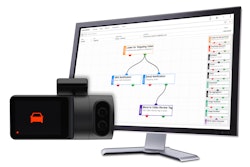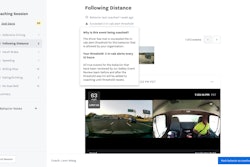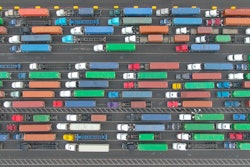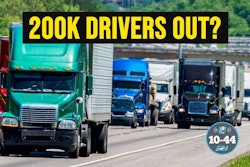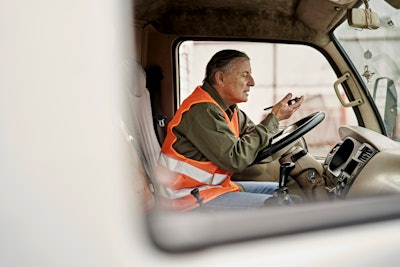
Every industry across the world is daily is increasingly infiltrated with new technology, changing the way the workforce functions, and the trucking industry is no different.
With all of today’s tech options – from ELDs and AI dashcams to the many data-driven apps, and even widely available autonomous vehicles on the horizon – tech providers are tasked with bridging the gap between veteran drivers in their 70s (or older) and the incoming generation of drivers as young as 18.
Darrin Demchuk, vice president of solutions at software company Platform Science, which provides telematics and fleet management services, said a 22-year-old doesn’t want to fill out literal paperwork but rather expects to use their smartphone for those types of tasks, while some older drivers are still challenged by the small handheld devices, among other technologies.
Transportation companies are migrating toward more technology on and in their trucks to help improve efficiencies, safety and ultimately cost savings while using it to attract the younger driver population. But despite the industry steadily moving toward digital operations, the older population is pushing back.
“It's not usually cut and dry of old needs this; young needs this. At the end of the day, the older or more experienced folks who have been in the industry for a while have experienced things a certain way, so you have a certain type of change management to deal with … and change can be intimidating to people, whereas younger people might be coming in with certain expectations of technology,” Demchuk said. “You have to manage expectations with the experienced and older drivers, help them change what they're used to, to introduce more automation and streamline, etc. Then you have to meet the expectations of the younger folks coming in who were born into technology.”
According to ScienceDirect, the main technology generations are mechanical (born before 1939); electromechanical (born 1939 to 1948); analog electronic (born 1949 to 1963); digital computer (born 1964 to 1978); internet (born 1979 to 1989); and internet plus social networking plus smartphone (born after 1989). Those in their 50s, 60s and 70s grew to maturity with analog electronic technology.
While the average age of currently employed truck drivers is in the 40s – most of whom have experience with technology – many trucking companies still have drivers in their 70s, and maybe even older, who are part of the electromechanical and analog generations that grew up with things like electric mixers and toasters and were later introduced to radios and microwaves.
Those generations now have to learn to use technology that goes beyond user interfaces like buttons, knobs or dials that were directly accessible and had only one function, to digital devices and software with multiple functions under each control while younger generations have come to not only expect but also demand the latter.
While transportation company cannot allow an aging driver population that may reject technology to dictate its adoption if it wants to maintain competitive in a market that requires technology to operate, the good news is older generations are becoming accustomed to using technology, too. According to AARP’s Tech Trends and the 50-Plus study, more than 70% of people in their 50s, 60s and 70s use technology to stay connected.
However, Doug Schrier, senior vice president of strategy at Transflo, said fleets still need to be mindful when selecting providers.
“One thing I can tell you about a professional driver, especially an older driver, is their trust is limited, and if you deploy technology to them that they ultimately can't trust, it’s really hard to win back that trust once you deployed something that wasn't quite ready,” he said.
Generational inclusion falls to the tech providers as they seek to meet fleet customers’ needs, but how do tech companies ensure inclusion across generations to help the industry transition to digital processes and create efficiencies until years down the road when driverless trucks or other innovations arrive to otherwise better alleviate or solve the truck driver crisis?
Schrier said it’s important to have a basic user experience that’s scalable to meet different needs and wants. For drivers old or young who may be less tech literate, he said they need the most basic option, while the more tech savvy may want additional features, even to the point of customizing their screen color.
“We spend a lot of time at Transflo worried about the usability of our software,” Schrier said. “What we find is that the practical use of software definitely drives key product adoption. If it's very simple to use, and it has high value for the driver, we generally get great adoption.”
He said fleets can take certain steps to increase the chances of adoption among older drivers and better guarantee a good ROI as they learn differently than those who grew up with modern technology in their hands.
Schrier said consider micro education sessions that walk drivers through one feature a day that is easy to use and exhibits the value of using the technology – like increased uptime, meaning more money and more home time – and they will be more open to exploring the remainder.
“Then the fourth feature is a much easier approach than trying to feed them all the features or how to use the app from front to back, inside and out, within a single session,” Schrier said.
Demchuk said it’s important to find a provider that offers more than one means of training. He said fleets should consider their driver base when implementing training and how each person learns differently.
“Traditionally, a lot of driver training occurred in classrooms, which for some folks makes perfect sense. That's where they learned a lot of stuff in life. But in this kind of distributed digital world today, you also want to have things like video libraries or digital content for the folks that may want to learn on the road, or at home or just want to look something up really quick,” he said. “You want to be able to basically offer the same type of training and user materials but in different formats so you can appeal to the various segments of your user base in general.”
Demchuk added that a provider needs to have a good migration plan as well. Schrier said fleets should be careful when selecting providers and pick one that offers customer service all the way down to the driver level.
They both agreed that when vetting providers, the driver should be top of mind. Both Platform Science and Transflo have user experience teams.
Demchuk said the Platform Science team will try multiple different ways of using a device – like putting on gloves to mimic thicker fingers and donning unnecessary eyeglasses and extending the device arm’s length – to experience it from the perspective of someone with poor eyesight. Schrier said Transflo goes out to truckstops to talk to drivers.
“Ask the drivers how they would solve this problem and how they want it solved for them,” Schrier said. “You’ll learn so much from someone who deals with it on a daily basis that our perceptions or our realities don’t consider frequently. You’ll come up with a different solution that is more aligned with what the drivers would expect.”




